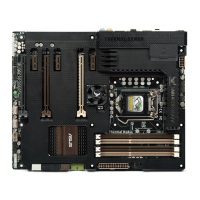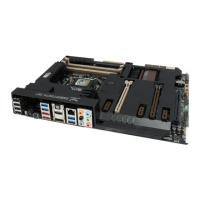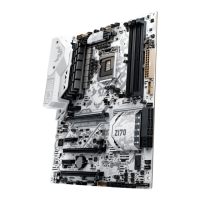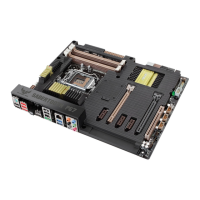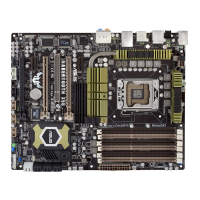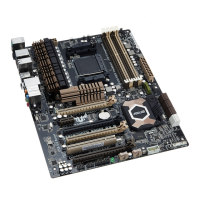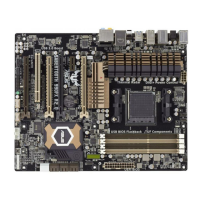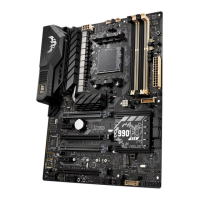Do you have a question about the Asus SABERTOOTH Z97 MARK 2 and is the answer not in the manual?
Information to prevent electrical shock hazard and ensure proper power supply connection.
Guidelines for safe installation and handling of motherboard components and system.
Details on CPU socket, chipset, and DDR3 memory configurations.
Details on SATA ports, Realtek audio codec, USB 3.0, and TUF features.
Introduction to the motherboard's special features and technologies.
Key features and specifications of the motherboard.
Description of Thermal Radar 2 and TUF ICe for temperature monitoring and fan control.
Details on Digital Power Control and TUF components for system stability.
Explanation of TUF ESD Guards and MemOK! for system protection and recovery.
Important precautions before installing motherboard components or changing settings.
Visual representation of motherboard connectors, jumpers, and slots.
Instructions and precautions for installing the CPU into the LGA1150 socket.
Information on the motherboard's DDR3 DIMM slots and memory configurations.
Details on installing varying memory sizes and compatibility considerations.
Information on the motherboard's PCI Express slots and their configurations.
Description and usage of the MemOK! button for memory compatibility tuning.
Details on various internal connectors for storage, audio, USB, and fans.
Step-by-step guide to assembling your PC system.
Instructions for installing the motherboard into the PC chassis.
Details on using screws to secure the motherboard to the chassis.
Illustrated guide for correctly installing the CPU into the socket.
Guide for mounting the CPU heatsink and fan, including thermal material application.
Procedure for installing and removing memory modules (DIMMs).
Instructions for connecting the ATX power supply to the motherboard.
Guide for connecting SATA hard disk drives and optical drives.
Procedure for installing PCIe x16 and PCIe x1 expansion cards.
Information on BIOS update utilities including EZ Update and EZ Flash 2.
Overview of rear panel I/O ports and audio connection types.
Diagram and list of rear panel connectors and their functions.
Steps for initial system power-up and POST check, including BIOS beep codes.
Introduction to UEFI BIOS, its functions, and when to change default settings.
Methods to enter BIOS Setup and general guidelines for using the program.
Overview of system information and changing BIOS security settings.
Overview of Ai Tweaker menu options for CPU and DIMM overclocking.
Settings for CPU and other system devices.
Managing SATA devices, including mode selection and hot plug support.
Enabling Legacy USB Support and configuring Intel xHCI mode for USB devices.
Information on Intel Rapid Storage Technology for RAID configurations.
Displaying system temperature, power status, and fan settings.
Changing system boot options including fast boot and SATA support.
Accessing special functions like EZ Flash 2 and OC Profile.
Options for loading default BIOS settings, saving changes, or discarding them.
Instructions for updating the motherboard BIOS using various utilities.
Using EZ Update for automatic BIOS, driver, and software updates in Windows.
Updating BIOS using a USB flash drive via EZ Flash 2 utility.
Restoring BIOS files using support DVD or USB flash drive after corruption.
Updating BIOS in DOS environment using support DVD and USB flash drive.
Integrated suite for launching and operating ASUS utilities.
Configuring audio settings using Realtek HD Audio Manager.
Introduction to Intel Rapid Storage Technology and RAID levels.
Explanation of RAID 0, RAID 1, RAID 5, and RAID 10 configurations.
Steps for loading the RAID driver during Windows OS installation.
Information to prevent electrical shock hazard and ensure proper power supply connection.
Guidelines for safe installation and handling of motherboard components and system.
Details on CPU socket, chipset, and DDR3 memory configurations.
Details on SATA ports, Realtek audio codec, USB 3.0, and TUF features.
Introduction to the motherboard's special features and technologies.
Key features and specifications of the motherboard.
Description of Thermal Radar 2 and TUF ICe for temperature monitoring and fan control.
Details on Digital Power Control and TUF components for system stability.
Explanation of TUF ESD Guards and MemOK! for system protection and recovery.
Important precautions before installing motherboard components or changing settings.
Visual representation of motherboard connectors, jumpers, and slots.
Instructions and precautions for installing the CPU into the LGA1150 socket.
Information on the motherboard's DDR3 DIMM slots and memory configurations.
Details on installing varying memory sizes and compatibility considerations.
Information on the motherboard's PCI Express slots and their configurations.
Description and usage of the MemOK! button for memory compatibility tuning.
Details on various internal connectors for storage, audio, USB, and fans.
Step-by-step guide to assembling your PC system.
Instructions for installing the motherboard into the PC chassis.
Details on using screws to secure the motherboard to the chassis.
Illustrated guide for correctly installing the CPU into the socket.
Guide for mounting the CPU heatsink and fan, including thermal material application.
Procedure for installing and removing memory modules (DIMMs).
Instructions for connecting the ATX power supply to the motherboard.
Guide for connecting SATA hard disk drives and optical drives.
Procedure for installing PCIe x16 and PCIe x1 expansion cards.
Information on BIOS update utilities including EZ Update and EZ Flash 2.
Overview of rear panel I/O ports and audio connection types.
Diagram and list of rear panel connectors and their functions.
Steps for initial system power-up and POST check, including BIOS beep codes.
Introduction to UEFI BIOS, its functions, and when to change default settings.
Methods to enter BIOS Setup and general guidelines for using the program.
Overview of system information and changing BIOS security settings.
Overview of Ai Tweaker menu options for CPU and DIMM overclocking.
Settings for CPU and other system devices.
Managing SATA devices, including mode selection and hot plug support.
Enabling Legacy USB Support and configuring Intel xHCI mode for USB devices.
Information on Intel Rapid Storage Technology for RAID configurations.
Displaying system temperature, power status, and fan settings.
Changing system boot options including fast boot and SATA support.
Accessing special functions like EZ Flash 2 and OC Profile.
Options for loading default BIOS settings, saving changes, or discarding them.
Instructions for updating the motherboard BIOS using various utilities.
Using EZ Update for automatic BIOS, driver, and software updates in Windows.
Updating BIOS using a USB flash drive via EZ Flash 2 utility.
Restoring BIOS files using support DVD or USB flash drive after corruption.
Updating BIOS in DOS environment using support DVD and USB flash drive.
Integrated suite for launching and operating ASUS utilities.
Configuring audio settings using Realtek HD Audio Manager.
Introduction to Intel Rapid Storage Technology and RAID levels.
Explanation of RAID 0, RAID 1, RAID 5, and RAID 10 configurations.
Steps for loading the RAID driver during Windows OS installation.
| Brand | Asus |
|---|---|
| Model | SABERTOOTH Z97 MARK 2 |
| Category | Motherboard |
| Language | English |



